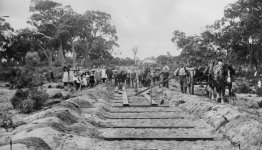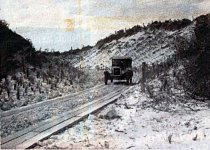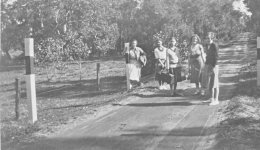Road pavers, yes long history. With basements in New England for instance you would still need a subfloor so I've seen some endgrain parquet but never an old house with anything but planks, I've been in plenty.
That is probably because end grain pieces not only would not be big enough, but on a suspended floor you would fall through. End grain flooring was always set on top of a sub-base. The last really old one I saw still in intended use was in 2001 in a printing plant. Although a local museum located in an old ice house still has one. I couldn't read the age from the rings as the floor is so old all of the significant ring variants are before any I know.
End grain floors were often used in early mills to provide support for machinery. Reduced vibration and prevented stationary equipment from moving. Bolting to the floor was a very involved process using star drills, sledge hammers and fill material. Weight and taking a set in the grain worked for much of the equipment.
Around here we still have "Plank" roads but in name only. If I get the chance I will look through my old engineering books to see the design methods.
The potato salad I make doesn't use mayo, it's more Euro style so a nice change from the mayo monster.
For the rollmops, maybe I could invert it and wrap a pickle slice around the herring?
Funnily enough I don't use mayo either for potato salad, I use a vinaigrette and sour cream.
For the herring salad though I make mayo from 1/4L oil, 2 yolks and a bit of cidre vinegar and then just add 500g cooked, sliced salad potatoes, three roasted beetroot, pickled gherkins, chopped onion, 5 or 6 rollmops cut into squares and 2 sweet apples. The apples are vital and it needs to sit ideally overnight.
Some early Perth history.Around here we still have "Plank" roads but in name only. If I get the chance I will look through my old engineering books to see the design methods.



The Old Plank Road
Perth region is totally sand so plank roads were the solution.
I shudder to think how much timber was used and the amount of labour involved.
Dan.
That is probably because end grain pieces not only would not be big enough, but on a suspended floor you would fall through.
I was talking residential flooring, i.e. people's houses. http://www.oldhouseonline.com/articles/the-history-of-wood-flooring
SY's not here to complain, he made us all some poached eggs the Ms. required extra cooking since snotty eggs do not go in.
While I do love the wings, brats, nachos and chili at Superbowl, I was pretty happy with this:
While your presentation is certainly better than mine, I contend my wings were contestably (is that a word?) tastier. However I did have really bad gas the next day.
I think I need to lay off fried foods.
While your presentation is certainly better than mine, I contend my wings were contestably (is that a word?) tastier. However I did have really bad gas the next day.
I think I need to lay off fried foods.
Take a tablespoon of angostura bitters. Cures the problem every time. Best with a couple ounces of bourbon and a shot of sweet vermouth.
Take a tablespoon of angostura bitters. Cures the problem every time. Best with a couple ounces of bourbon and a shot of sweet vermouth.
Herbal bitters works every time Campari, etc. Boonekamp if you can find it.
Add in some red ("Italian") sweet vermouth and you've got a Manhattan Cocktail.
Bourbon + Angostura Bitters + red vermouth = Manhattan.
At one all inclusive resort this was my way to avoid the heavy sweet drinks, brandy and sweet vermouth on ice.
I contend my wings were contestably (is that a word?) tastier. However I did have really bad gas the next day.
I bet the wings were good, no contesting that.
About the gas; there are many cures out there but when feeling bloated and kinda heartburny, my favourite is to guzz a cold beer, go outside and jog around the block. Something good always comes of it but maybe not right away or in the order you hoped for.
At one all inclusive resort this was my way to avoid the heavy sweet drinks, brandy and sweet vermouth on ice.
Had that (exactly) at a place overlooking Lago Maggiore about 6 or 7 years ago.
Add in some red ("Italian") sweet vermouth and you've got a Manhattan Cocktail.
Bourbon + Angostura Bitters + red vermouth = Manhattan.
I'm more of an Old Fashioned man myself. Angostura + sugar + orange peel + whisky + ice. Note I said "whisky", I happen to believe that both Old Fashioned and Manhattan are better with Rye (aka "Canadian Whisky") than with bourbon; the latter is too sweet and cloying and overpowers the drink, while the lightness of a good Rye blends better with other ingredients. I also like to remember that when a lot of cocktails were invented, bourbon wasn't available in the USA, they had to use smuggled Canadian whisky.
Speaking of which: Last week I was in my local food retailer and noticed they had Seville oranges. Although I still have some 2016 marmalade, and at least one jar of the 2015 (a bad year), I don't like to run out so grabbed a few (OK 8). Now an Old Fashioned, made to the "classic" recipe, involves saturating a sugar cube with bitters, adding a few dashes of water, and muddling that with a piece of orange peel, before adding ice and whisky. I generally find that a little too sweet, and often use a double measure of whisky to offset the sugar. When I got the Seville oranges home I had an inspiration, and made an Old Fashioned but using a piece of the intense and very bitter Seville orange peel (stealing from future marmalade). It was the best Old Fashioned I ever had! Pity one can only get Sevilles this time of year.
Perth region is totally sand so plank roads were the solution.
I shudder to think how much timber was used and the amount of labour involved.
Dan.
Around here they used to use "corduroy roads", are you familiar with those? Basically they laid lengths of tree trunk (likely spruce around here) crosswise over the road bed, it helped when things were muddy, carriages wouldn't sink up to their axles. Of course, the ride was pretty rough even in the best conditions, but made the road passable most of the year.
No I haven't seen or heard of those before, must have been a pita.
In Aus there is pretty much no such thing as trees with long, smooth, round round trunks suitable for the use you describe.
The main Aus species is Eucalypt, which is random/fractal in form so any usage is necessarily sawn or split.
I understand many/most US highways are concrete.
Not so here, with the exception of one short highway section in Brisbane built by the Septic Tanks (Yanks) in WW2, all Aus roads are ashphalt.
Dan.
In Aus there is pretty much no such thing as trees with long, smooth, round round trunks suitable for the use you describe.
The main Aus species is Eucalypt, which is random/fractal in form so any usage is necessarily sawn or split.
I understand many/most US highways are concrete.
Not so here, with the exception of one short highway section in Brisbane built by the Septic Tanks (Yanks) in WW2, all Aus roads are ashphalt.
Dan.
- Home
- Member Areas
- The Lounge
- The food thread